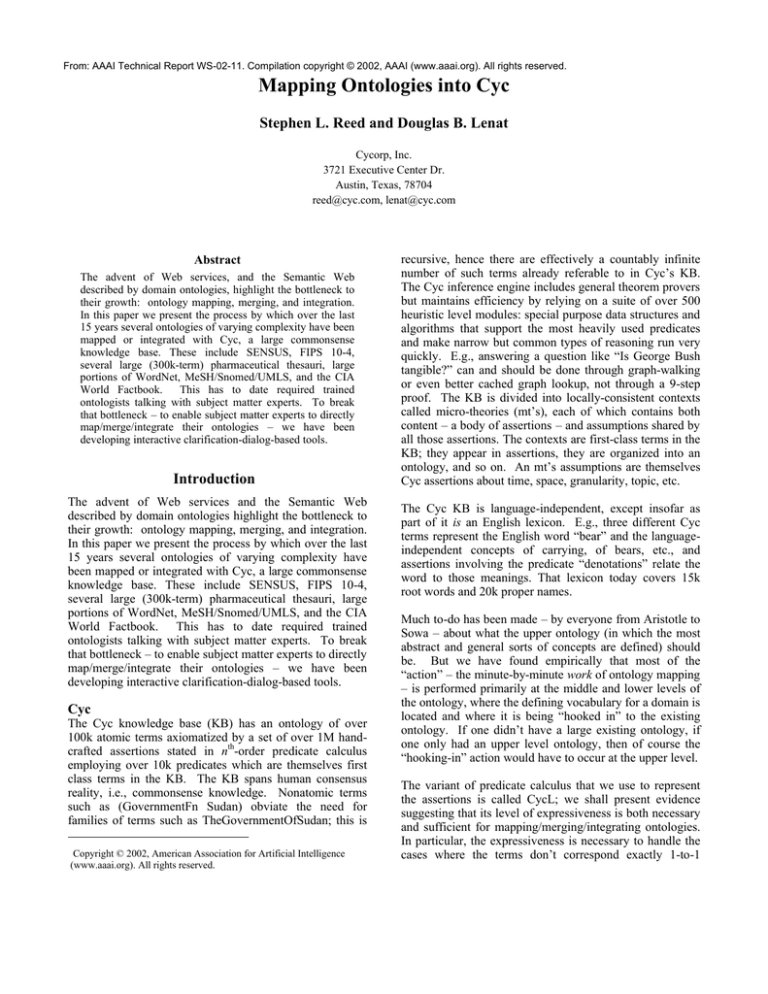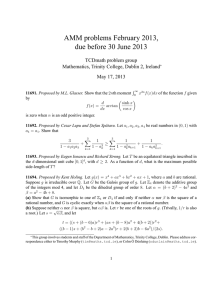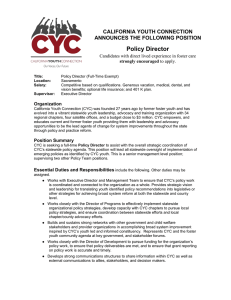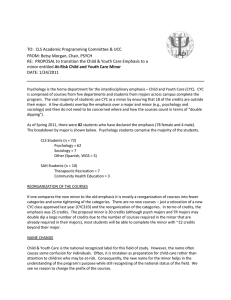
From: AAAI Technical Report WS-02-11. Compilation copyright © 2002, AAAI (www.aaai.org). All rights reserved.
Mapping Ontologies into Cyc
Stephen L. Reed and Douglas B. Lenat
Cycorp, Inc.
3721 Executive Center Dr.
Austin, Texas, 78704
reed@cyc.com, lenat@cyc.com
Abstract
The advent of Web services, and the Semantic Web
described by domain ontologies, highlight the bottleneck to
their growth: ontology mapping, merging, and integration.
In this paper we present the process by which over the last
15 years several ontologies of varying complexity have been
mapped or integrated with Cyc, a large commonsense
knowledge base. These include SENSUS, FIPS 10-4,
several large (300k-term) pharmaceutical thesauri, large
portions of WordNet, MeSH/Snomed/UMLS, and the CIA
World Factbook.
This has to date required trained
ontologists talking with subject matter experts. To break
that bottleneck – to enable subject matter experts to directly
map/merge/integrate their ontologies – we have been
developing interactive clarification-dialog-based tools.
Introduction
The advent of Web services and the Semantic Web
described by domain ontologies highlight the bottleneck to
their growth: ontology mapping, merging, and integration.
In this paper we present the process by which over the last
15 years several ontologies of varying complexity have
been mapped or integrated with Cyc, a large commonsense
knowledge base. These include SENSUS, FIPS 10-4,
several large (300k-term) pharmaceutical thesauri, large
portions of WordNet, MeSH/Snomed/UMLS, and the CIA
World Factbook. This has to date required trained
ontologists talking with subject matter experts. To break
that bottleneck – to enable subject matter experts to directly
map/merge/integrate their ontologies – we have been
developing interactive clarification-dialog-based tools.
Cyc
The Cyc knowledge base (KB) has an ontology of over
100k atomic terms axiomatized by a set of over 1M handcrafted assertions stated in nth-order predicate calculus
employing over 10k predicates which are themselves first
class terms in the KB. The KB spans human consensus
reality, i.e., commonsense knowledge. Nonatomic terms
such as (GovernmentFn Sudan) obviate the need for
families of terms such as TheGovernmentOfSudan; this is
Copyright © 2002, American Association for Artificial Intelligence
(www.aaai.org). All rights reserved.
recursive, hence there are effectively a countably infinite
number of such terms already referable to in Cyc’s KB.
The Cyc inference engine includes general theorem provers
but maintains efficiency by relying on a suite of over 500
heuristic level modules: special purpose data structures and
algorithms that support the most heavily used predicates
and make narrow but common types of reasoning run very
quickly. E.g., answering a question like “Is George Bush
tangible?” can and should be done through graph-walking
or even better cached graph lookup, not through a 9-step
proof. The KB is divided into locally-consistent contexts
called micro-theories (mt’s), each of which contains both
content – a body of assertions – and assumptions shared by
all those assertions. The contexts are first-class terms in the
KB; they appear in assertions, they are organized into an
ontology, and so on. An mt’s assumptions are themselves
Cyc assertions about time, space, granularity, topic, etc.
The Cyc KB is language-independent, except insofar as
part of it is an English lexicon. E.g., three different Cyc
terms represent the English word “bear” and the languageindependent concepts of carrying, of bears, etc., and
assertions involving the predicate “denotations” relate the
word to those meanings. That lexicon today covers 15k
root words and 20k proper names.
Much to-do has been made – by everyone from Aristotle to
Sowa – about what the upper ontology (in which the most
abstract and general sorts of concepts are defined) should
be. But we have found empirically that most of the
“action” – the minute-by-minute work of ontology mapping
– is performed primarily at the middle and lower levels of
the ontology, where the defining vocabulary for a domain is
located and where it is being “hooked in” to the existing
ontology. If one didn’t have a large existing ontology, if
one only had an upper level ontology, then of course the
“hooking-in” action would have to occur at the upper level.
The variant of predicate calculus that we use to represent
the assertions is called CycL; we shall present evidence
suggesting that its level of expressiveness is both necessary
and sufficient for mapping/merging/integrating ontologies.
In particular, the expressiveness is necessary to handle the
cases where the terms don’t correspond exactly 1-to-1
across ontologies, but rather require a full-fledged axiom to
express the mapping.
that semantically maps to the Cyc Collection COL, and as a
slot that maps to the Cyc BinaryPredicate RELN.
Cyc has one general-purpose code mapping function:
Background
Ontology mapping is related to the well researched areas of
taxonomy and thesaurus merging. Doerr [2001], describes
semantic differences among thesauri that affect the
mapping process. Wiederhold [1994], describes ontology
composition,
and
domain
ontology
differences.
Generalizing these findings and adding other semantic
issues peculiar to Cyc, we obtain the following list of
differences between a source ontology and the Cyc
ontology (in order of complexity):
♦ Terminological Differences
• Different names for the same concept
• Related but different concepts
• More specialized or general versions of the same
concept
• Attributes vs. functions vs. predicates representation
♦ Simple Structural Differences
• Two ontologies are similar yet disjoint
• One ontology is a subset of the other
• One ontology is a reorganization of the other
♦ Complex Structural Differences
• E.g., having action predicates vs. reified events
♦ Fundamentally different representations
• E.g., Bayesian probabilistic vs. truth-logic
Term Mapping Experience
Term mapping (to Cyc’s ontology) constitutes the majority
of our ontology mapping experience. The source ontology
typically contains a finite set of terms having well defined
attributes. The source term taxonomy is usually used in the
mapping, but that is not always the case.
Term Mapping Meta Ontology
Cyc has three general-purpose term mapping predicates:
(MeaningInSystemFn INFOSOURCE STRING), applied to a
character string or code STRING in some external information system INFOSOURCE, returns whatever concept is meant
by that string or code in that system.
E.g., the value of
(MeaningInSystemFn
WordNet-1995Version
“N221566”)
is the concept (or WordNet synset) represented by the
synonyms (rampart|bulwark|wall), meaning “an embankment built around a space for defensive purposes” in the
WordNet ontology.
We now give a few examples of our experience using this
machinery to map various ontologies to Cyc’s.
FIPS 10-4
The Federal Information Processing Standards (FIPS) are a
set of standards that describe document processing codes.
We mapped FIPS codes that designate non-US countries
and their principal administrative subdivisions into Cyc,
creating new terms for geographical entities not already in
Cyc. This is the simplest form of ontology mapping, in
which a single relationship is mapped, and in which the
missing terms in the reference Cyc ontology are easily
identified and created. A single microtheory (context)
contains the mapping assertions. Should it be required to
subsequently map a new version of the FIPS country and
city codes, then a new microtheory will be created for that
mapping.
For the below mapping assertion, we created the term
Waikohu-CountyNewZealand and associated the code
“NZ86” with Waikohu, the New Zealand county.
Furthermore, the new term was asserted to be a geopolitical
subdivision of New Zealand, as that fact was given by the
source ontology.
(synonymousExternalConcept TERM SOURCE STRING)
means that the Cyc concept TERM is synonymous with the
concept named by STRING in the external data source
SOURCE. This is the simplest sort of 1-to-1 term mapping.
(overlappingExternalConcept TERM SOURCE STRING)
means that the Cyc concept TERM overlaps semantically
with the concept named by STRING in the external data
source SOURCE. Either the overlap is almost complete, or
else the relationship is unclear, or else this next predicate
should be used instead of overlappingExternalConcept:
(extConceptOverlapsColAndReln COL RELN SOURCE
STRING) means that the external structured data source
SOURCE variously uses the term named by STRING as a value
(synonymousExternalConcept WaikohuCountyNewZealand FIPS10-4Information1995 "NZ86")
(geopoliticalSubdivision NewZealand WaikohuCountyNewZealand)
We mapped 3,418 terms from the FIPS 10-4 ontology into
Cyc.
MeSH
Medical Subject Headings (MeSH) were mapped into Cyc
from the expanded 1997 version of the National Library of
Medicine thesaurus of Medical Subject Headings. We
created not only new terms for concepts new to Cyc but
created new relationships and linked the mapped source
terms into a semantically richer portion of the Cyc KB.
For example:
(overlappingExternalConcept
InferiorMesentericVein MeSH-Information1997
"Mesenteric Veins | A7.231.908.670.385")
(isa InferiorMesentericVein
UniqueAnatomicalPartType)
(genls InferiorMesentericVein Vein)
(genls InferiorMesentericVein
DirectedCustomaryPath)
The last assertion for the mapped term "Mesenteric Veins |
A7.231.908.670.385", states that the Inferior Mesenteric
Vein is a subclass of DirectedCustomaryPath, which
enables Cyc to reason about the vein as a mathematical
directed graph system. We mapped 252 terms from MeSH
to Cyc.
SENSUS
SENSUS is a large, 70,000 term ontology derived from
WordNet and the Pennman Upper Model. We mapped 201
SENSUS terms that matched existing Cyc terms. For
example:
(synonymousExternalConcept
DisjointSetOrCollection
SENSUS-Information1997 "DISJUNCTIVE-SET")
Open Directory
The Open Directory web topic directory is a very large
taxonomy of over 400,000 classes and 3,000,000 instances
which is available in RDF. In a commercially sponsored
effort, we linked over 10,000 class terms to Cyc, using a
workflow application to guide our knowledge workers
through the process of linking an Open Directory topic to
existing Cyc terms, and creating new Cyc terms when
required. Our experience with Open Directory highlights
the drawbacks of a semiautomatic mapping to a source
ontology that is undergoing constant enhancement and
refactoring. The Open Directory element IDs were not
preserved when their editors refactored a category. Thus
we faced an ever growing mapping maintenance burden
that ultimately proved insurmountable. We have removed
the mappings from Cyc until the customer need arises, and
our ability allows fully automatic maintenance of the links.
WordNet
WordNet has become the standard lexical knowledge base
with over 130,000 English words and phrases organized
into taxonomies by parts of speech. The words are grouped
into synonym sets (synsets) and assigned an ID. Like Open
Directory, the synset ids are changed when new versions of
the ontology are released, but a backwards compatibility
utility program is provided to map synsets between
versions. We mapped over 12,000 Cyc terms to WordNet
version 1.6 and continue to support WordNet mapping via
a graphical tool built into Cyc. Below are examples of
mapping a WordNet noun synset, adverb synset, and verb
synset:
(synonymousExternalConcept
ShoppingMallBuilding WordNet-1997Version
"N03144979")
(synonymousExternalConcept West-Generally
WordNet-1997Version "R00318751")
(synonymousExternalConcept
(TransportViaFn RoadVehicle)
WordNet-1997Version "V01317106")
In the above assertion, the functional expression
(TransportViaFn RoadVehicle) means the collection of
transportation events in which a (more or less
conventional) road vehicle is the transportation device.
Cyc’s functional term notation is frequently used when
mapping source ontologies so that new concepts can be
formed by composing existing concepts, rather than
creating a new reified term for each one.
Simple Ontology Integration
We mapped Cyc relationships to the numerous but simple
geographical, economic and governmental relationships
found in the CIA World Factbook 1997 ontology. Then we
imported over 5,900 facts into Cyc using these
relationships. Here are three examples from what Cyc was
told in 1998 – and still knows – about the country of
Ireland:
(altitudeOfHighestPointIs Ireland-TheNation
(Meter 1041))
(budgetExpenditureFractionOfGDP
Ireland-TheNation
GovernmentMilitaryOrganization
(YearFn 1997)
(Percent 1.3))
(lengthOfPathTypeInRegion Ireland-TheNation
GasPipeline
(Kilometer 225))
Single Namespace in Cyc
Cyc knowledge entry and ontology mapping methodology
requires that terms exist within a single universal
namespace. We distinguish between like-named words via
a convention of term name suffixes as shown in the above
example for Ireland-TheNation as contrasted with
Ireland-TheIsland. To reiterate: the terms in Cyc
correspond to meaningful real-world concepts; they map to
English words on a many-to-many basis, not 1-to-1.
mathematical modeling, and specialized
straightforward mapping of UML instances.
for
the
Important new specializations of this new term will be:
DAML Ontology Import / Export
The DARPA Agent Markup Language (DAML) can be
imported and exported from Cyc. We have created KB
subsets in DAML format for various users and posted them
at the http://www.daml.org web site. When importing
DAML classes and instances, we expect only the meta
classes and meta properties to initially map to Cyc, as
DAMLs taxonomic properties are very similar to Cyc isa
and genl subsumption predicates. When we imported the
NAICS (North American Industry Classification System)
and UNSPSC (Universal Standard Products and Services
Classification), we used Cyc’s phrase parser on the term
names in an attempt to partially automate the term
mapping. We found that a specialized workflow tool (at
least as sophisticated as the Open Directory linking tool
mentioned above) was highly cost-effective to develop and
employ, to speed up the integration of the more than 10k
terms of these two product & services ontologies with
Cyc’s.
MathematicalModel,
(genls MathematicalThing and Individual)
MathematicalContainer,
(like Container which is for tangible objects)
mathematicallyContains
(like physciallyContains)
mathematicalParts (like parts)
ObjectOrientedComponent
(genls ComputationalObject)
inheritObjectOrientedFeatures
(somewhat like inheritIdentityToSubscenes)
Unlike most UML tools which hard-code (or ignore) the
UML well-formedness constraints, we can directly map and
represent these constraints as first order logical rules in
Cyc. For example the first UML V1.4AS Core WellFormedness rule for Association is: “The AssociationEnds
must have a unique name within the Association.
UML OCL (Object Constraint Language) source rule:
XML schema mapping
Mapping ordinary XML schema to Cyc is naturally more
difficult than mapping a DAML ontology, because the
XML schema generally does not include taxonomic
information for classes and properties. We expect,
however, that tools that use semantic clues parsed from
XML tag names will partially remedy this, and prove useful
in both DAML and ordinary XML ontology mapping.
UML Ontology Integration
self.allConnections à
forAll( r1, r2 | r1.name = r2.name à r1 = r2)
This can be quite easily mapped into Cyc as:
(implies
(and
(connectionOf-UMLComponent ?R1 ?ASSOC)
(connectionOf-UMLComponent ?R2 ?ASSOC)
(equals
(NameOf-UMLComponent ?R1)
(NameOf-UMLComponent ?R2)))
(equals ?R1 ?R2))
We are beginning to map the core elements of the Unified
Modeling Language (UML) into Cyc. This enables Cyc to
better understand computer system interfaces and their
behavior when modeled with UML. Our work to date on
this task suggests that UML may prove to be sufficiently
expressive to serve as the reference Cyc ontology for
system models, i.e. Cyc’s vocabulary for system modeling
will derive from UML.
Argument type constraints on the predicate connectionOfUMLComponent ensure that the first argument is a
AssociationEnd and that the second argument is a
Association-UMLComponent. So we omit the following
redundant conjuncts from the rule’s antecedent:
Cyc Upper Ontology Enhancement
Our steady stream of work provides ongoing feedback on
the Cyc ontology, causing revisions, combinations, and
new terms to be defined at the lower, (more rarely) middle,
and (even more rarely) upper levels.
Structured Text Ontology Integration
One of the most recent examples of the latter, e.g., was the
concept of an abstract container, an object that can
encapsulate intangible things and model the containment
behavior of UML packages and classifiers. That concept
was necessary to introduce new Cyc collections (classes)
and predicates (properties) generalized for commonsense
(isa ?ASSOC Association-UMLComponent)
(isa ?R1 AssociationEnd)
(isa ?R2 AssociationEnd)
During a recent workshop for INSCOM (US Army
Intelligence and Security Command), we mapped instances
of structured text into Cyc. The source ontology was in a
format similar to that established by the MUC (Message
Understanding Conference), with named entities having
relationships and descriptions. Here is an example of a
source ontology instance, in which the named entity “North
Africa” was extracted from a web document:
(LOCATION-null-1 ENTITY LOCATION
(NAME "North Africa")
(TYPE LOCATION)
(SUBTYPE REGION)
(COUNTRY "North Africa"))
Because the source ontology is semi-structured (having text
elements as values), mapping the instances into Cyc
requires NL phrase parsing. The Cyc lexicon contains an
exact match for the phrase “North Africa”. We mapped the
instance to the Cyc assertions:
(isa NorthernAfrica GeographicalRegion)
(isa LOCATION-null-1 NorthernAfrica)
In another case, the source ontology instance was a named
entity for which the NAME attribute was “car full of
explosives”. Our NL phrase parser was able to parse the
concept Automobile, but not the complete meaning of the
phrase. Well formed formula (wff) constraints, present in
the reference Cyc ontology, prevent the mapping of
semantically incorrect facts, discarding for example the
mapping of the NAME “Algerian” to a geographical location.
Cyc parses that phrase as AlgerianPerson, and Cyc has a
high level assertion from which it can deduce that all
instances of Person are disjoint from all instances of
IndependentCountry. In the justification below, the genls
predicate is Cyc’s term for the subclass relationship.
“No person is a country.”
(disjointWith Person IndependentCountry)
Justification :
(genls Person Primate)
(genls Primate Eutheria)
(genls Eutheria Mammal)
(genls Mammal Homeotherm)
(genls Homeotherm Animal)
(genls Animal EukaryoticOrganism)
(genls EukaryoticOrganism Organism-Whole)
(genls Organism-Whole
BiologicalLivingObject)
(disjointWith BiologicalLivingObject
Artifact-Generic)
(genls Organization Artifact-Generic)
(genls GeopoliticalEntity Organization)
(genls Country GeopoliticalEntity)
(genls IndependentCountry Country)
Our experience demonstrates that structured text in a
source ontology can be utilized to parse facts, with the
drawbacks that imprecision is introduced and that only a
portion of the text meaning will be likely understood.
Structured Knowledge Source Integration
When mapping a structured knowledge source (SKS) such
as a web service or relational database, both the structural
schema and the access protocol are mapped into Cyc, thus
enabling dynamic access and mapping from the source to
satisfy a request. We recently added two mapping
predicates to Cyc’s ontology, to facilitate SKS integration:
synonymousListFields
and overlappingListFields
These predicates associate a Cyc term with a list of strings
from the structured knowledge source that jointly map to
the term. The latter predicate indicates that the meaning of
the Cyc term overlaps the meaning of the source concept.
Knowledge Source Navigation / Access Protocol
Navigation and access protocols for SKSI are to be handled
as cases: The most common are relational databases that
are accessed via SQL. Many web services are lightweight
interfaces using a relational database backend. Cyc uses its
knowledge of the mapped DB schema to create SELECT
statements or to populate the parameters of DB stored
procedures, when satisfying requests.
Increasingly, web services have structured knowledge
source schema based on XML (including DAML and
RDF), and where the access protocol is SOAP or another
web services standard. Building upon our experience with
SQL, we intend to develop a generic driver program for
web services whose behavior is governed in a declarative
fashion by assertions in the Cyc KB.
The more complex case of navigation and access protocols
arises from the need to interface software systems that have
system specific APIs. We can model these protocols via
agent conversation vocabulary, in which performatives
model API function calls.
The Role of English Dialogue-Based Tools
The burden of inputting individual software system APIs
into Cyc as modeled schema and access protocols, can be
addressed by tools that carry on a clarification back-andforth dialogue with a subject matter expert (SME) – e.g., a
chemist or a tank commander – who does not need to have
training in formal logic, ontologies, programming, etc. In
other words, Natural Language parsing, understanding, and
generation are employed to insulate the SME from having
to read or write CycL (the predicate calculus representation
language used throughout this paper, and by Cyc itself.)
Cyc now has such dialogue-based tools, written for the
DARPA Rapid Knowledge Formation (RKF) project.1
These tools have been used to guide SMEs through the
acquisition of new domain knowledge, including terms,
facts, rules, and scripts. Using mixed initiative, they ask the
SME about salient properties of a new term. As an example
of such “guiding”, a SME says “TR1 can kill people”, and
Cyc asks (1) if TR1 can kill some broader category
(primates, mammals, etc.), and (2) the manner in which the
killing occurs (infection, wounding, etc.)
We plan to refactor the toolkit for the input of structured
knowledge source schema and access protocol. RKF
allows the testing of new knowledge as it is input.
Similarly, RKF style SKSI tools will enable the testing of
the source access protocol during the knowledge entry
process, detecting errors at the earliest stage. Based on our
experience during 2001 (RKF Year 1), we would expect
dialogue-based tools for SKSI to work best at the fringe of
what Cyc already knows. So we need to build up Cyc’s
knowledge of system structure and access protocols, which
complements the mapping of UML models to Cyc.
Conclusion
Progressing through increasingly complex ontology
mappings into Cyc, we find that the major barrier to
adoption of ontology mapping for sophisticated web
services will be the requirement for someone to input the
source schema and access protocols. Our experience with
the Open Directory linking tool, which incorporated some
parsing of RDF tag names, shows that thousands of terms
can be mapped into Cyc with a team of skilled knowledge
workers. We need to combine the best features of this
approach with RKF tools that enable SMEs, as opposed to
skilled knowledge workers, to perform the mapping effort.
Further research and development is required to enhance
Cyc’s commonsense knowledge of system interfaces and
behavior. Perhaps the Unified Modeling Language can
serve as Cyc’s reference ontology for system and service
description, gaining leverage from an industry standard and
numerous CASE tools that exchange system design
information in the UML XMI format. The ontology
DAML-S, whose instances describe web services, will
certainly be integrated into Cyc’s ontology during the
DAML program.
1
Some of our RKF tools, including some which were built by Ken
Forbus at NWU, enable SMEs to describe new knowledge using analogy.
Some still-in-development RKF tools include those with sketching tablet
interfaces.
References
Central Intelligence Agency. 2001. The CIA World
Factbook
URL: http://www.cia.gov/cia/publications/factbook/
Features of CycL. Cycorp
URL: http://www.cyc.com/cycl.html
Federal Information Processing Standards Publication 104. 1995. Countries, Dependencies, Areas of Special
Sovereignty, and Their Principal Administrative Divisions.
Doerr, M. 2001. Semantic Problems of Thesaurus Merging.
Journal of Digital Information. 1(8)
Fellbaum, C., editor. 1998. WordNet An Electronic Lexical
Database. The MIT Press.
Knight, K and Luk, S. K. 1994. Building a LargeScale
Knowledge Base for Machine Translation. Proceedings of
the American Association of Artificial Intelligence
Conference, Seattle, Washington: AAAI Press.
Lenat, D. B. 1995. Cyc: A Large-Scale Investment in
Knowledge Infrastructure. The Communications of the
ACM 38(11):33-38
National Library of Medicine. 2002. Medical Subject
Headings. URL:
http://www.nlm.nih.gov/pubs/factsheets/mesh.html
Pinto, H. S., Gomez-Perez, A., and Martins, J. P. 1999.
Some issues on ontology integration. Proceedings of the
Workshop on Ontologies and Problem Solving Methods
during
IJCAI-99, Stockholm, Sweden.
URL: http://citeseer.nj.nec.com/pinto99some.html
Rumbaugh, J., Jacobson, I. and Booch, G. 1998. The
Unified Modeling Language Reference Manual. AddisonWesley
Wiederhold, G. 1994. An Algebra for Ontology
Composition. Proceedings of 1994 Monterey Workshop on
Formal Methods, Sept 1994, U.S. Naval Postgraduate
School, Monterey CA :56-61. URL:
http://citeseer.nj.nec.com/wiederhold94algebra.html





